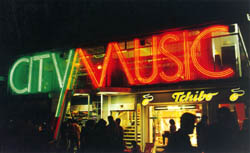|
 I
visited Berlin a year and a half after the reunification of Germany
on October 3, 1990, by which time there was no longer any sign of the
towers that had symbolized the division of the country in the vicinity
of the Brandenburg Gate. I
visited Berlin a year and a half after the reunification of Germany
on October 3, 1990, by which time there was no longer any sign of the
towers that had symbolized the division of the country in the vicinity
of the Brandenburg Gate.
However, looking all around from the lookout point on the TV tower
a short distance away, the difference between the eastern and the western
halves of the city was all too obvious. On the East German side one
could see nothing but gray apartment blocks and groups of buildings,
presumably factories, stretching far away into the distance. In contrast,
the West German side offered a view over the expansive Tiergarten Park
of a prosperous urban landscape with splendid modern buildings. A sun-tanned
middle-aged couple, instantly recognizable as hailing from the provinces,
sipped their coffees in a rotating restaurant as they gazed out on the
rare spectacle before them. Young people from the east stepping for
the first time into the Kurfurstendamm, Berlinfs pleasure district,
must have felt they were setting foot in an oasis. The large neon signs
of the music shop close to the entrance to this street symbolized the
lure of consumerism and served as a magnet for the cityfs young.
Today, when almost a decade has passed since reunification, the economic
and cultural disparities between east and west show little sign of shrinking
and seem, if anything, to be increasing. With their dreams of freedom
and prosperity, what has actually confronted the people of East Germany
is the harsh reality of capitalism.
|

